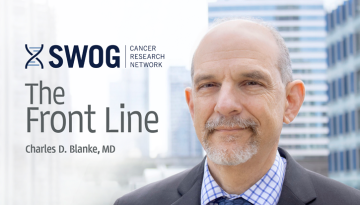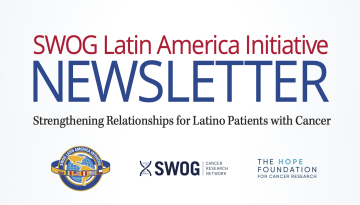A SWOG December to Remember
December is typically a notable month for SWOG results, with the spotlight on major meetings in breast cancer and hematology, and this December has been particularly fruitful. In reviewing (for the annual report to the NCI, as well as our own upcoming Impact Report) some of the most noteworthy results our investigators have presented and published in recent weeks, a couple of clear themes emerge.
The first is an expansion of personalized medicine, with even more precision targeting. The second is a focus on refining treatment regimens for older patients, to make them both easier to tolerate and more effective. Here are the details:
- Our RxPONDER S1007 trial garnered international attention last December, when the first results were reported at the 2020 San Antonio Breast Cancer Symposium (SABCS). Those results demonstrated that postmenopausal women with HR+, HER2- breast cancer that has spread to 1-3 lymph nodes and who have a 21-gene recurrence score of 25 or less can safely forego chemotherapy, relying on endocrine therapy alone. The RxPONDER team, led by Dr. Kevin Kalinsky, has now published the definitive results in the New England Journal of Medicine, and Dr. Kalinsky presented additional analysis at the 2021 SABCS last week. In brief, the study’s main findings have now been confirmed as measured by invasive disease-free survival (the study’s primary endpoint), distant disease-free survival, and distant relapse-free interval.
- Other SWOG work presented at the SABCS also involved the use of the 21-gene recurrence score, in this case in conjunction with another assay built on measurement of gene expression known as the sensitivity-to-endocrine-therapy (SET2,3) index. Dr. Corey Speers led a team that analyzed data from SWOG’s landmark S8814 trial in postmenopausal patients with HR+, lymph node-positive breast cancer. Speers’s team found that the SET2,3 index has prognostic value that is independent of and complements the prognostic value of the recurrence score. They conclude that using the two tests together may be better than either test by itself to identify which patients will do well with endocrine therapy alone and which patients are at higher risk and may need additional therapy.
- At the American Society of Hematology (ASH) annual meeting last week, SWOG biostatistician Megan Othus, PhD, gave an oral presentation on statistical models she and a team that included researchers from the UK had developed that predicted the risk of early death in patients being treated with non-intensive therapies for acute myeloid leukemia (AML). Some patients with AML, particularly patients aged 75 and older, have difficulty tolerating the side effects of the intensive chemotherapy that is the standard treatment. These patients often receive a less intensive course of treatment. The models Othus presented on, which the team validated using data sets from several SWOG studies, are the first known to have success in predicting which patients in this group are likely to benefit from less intensive therapies for their AML. Notably, among the several models they tested, the most successful were those that incorporated a standard patient-reported outcome (PRO) measure of quality of life.
- Finally, Dr. Anjali Advani presented results at ASH from the Philadelphia chromosome-positive (Ph+) cohort of SWOG’s S1318 trial in acute lymphoblastic leukemia (ALL). That study also focuses on older patients who have difficulty tolerating the effects of intensive chemotherapy. S1318 patients with Ph+ ALL were treated with a regimen that added an immunotherapy drug, blinatumomab, to dasatinib and prednisone, which are standard parts of a less intensive course of treatment. The study team reported an improved estimated three-year disease-free survival rate compared to that for treatment with dasatinib and steroids alone. Follow-up data will be needed to confirm whether adding blinatumomab will mean longer remissions for these patients, but the initial results reported here are promising
In a few weeks I’ll update you on that 2021 Impact Report, reviewing the highlights of the entire year. For now, though, this is work all of us at SWOG can be proud of!
Other Recent Stories



